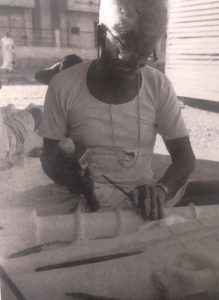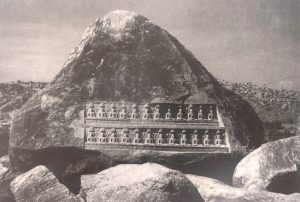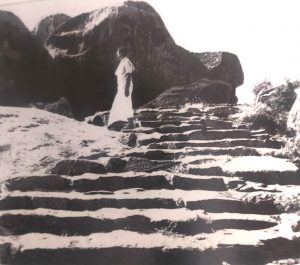Tha Genesis and Spirit of Jaina Art
Jyoti Prasad Jain
The avowed aim of the Jaina religion is the perfection of man, or the transformation of the individual mundane soul (atman) into the very state of Godhood (paramatman). It exhorts and helps to bring out the divinity inherent in a person through the realization of the spiritual Self. The path generally is one of severe discipline, self-control, renunciation and austerity.
But art, too, may be said to be, in a way, one of the purest means to attain, and become one with, the Divine, and it would perhaps not be an exaggeration to say that nothing more nearly approaches the spirit of true religion than the spirit of true art’.
The emotional, devotional and popular aspects of the creed as well necessitated the creation of various works of art and architecture, and in making them really beautiful no pains or money were spared. Nevertheless, the spirit of the Jaina religion is clearly reflected in its art, which, though very varied and luxuriant, is characterized by a marked absence of the erotic, vulgar or common.
It is rather sober, sublime and uplifting, inspiring feelings of self-abnegation, peace and equanimity, besides giving aesthetic pleasure. A sort of unworldliness that is attached to it is conducive to the attainment of spiritual contemplation and the upper reaches of self-realization.
Pieces of Jaina art and architecture belonging to different types and ages are scattered all over the country, but the places of Jaina pilgrimage are in particular veritable store-houses. And the ideal of a religious aspirant in Jainism is exactly what the term “pilgrim’ implies, namely, ‘one journeying through life as a stranger in the world’.
He lives his life in the world and scrupulously performs his duties and discharges his obligations; yet his attitude is that of a stranger, an onlooker or an observer. He does not identify himself with the show, does not let himself be engrossed in worldly relations and objects. He is a pilgrim who journeys through the world, taking the triple path, made up of Right Faith, Right Knowledge and Right Conduct, and pursues his spiritual pilgrimage till he attains the goal, nirvana.
As a matter of fact, in Jainism a place of pilgrimage is called a tirtha (literally, a ford), because it helps the aspirant in crossing over the ocean of samsara which is full of pain and misery, and in attaining liberation from the otherwise unending round of births and deaths. The primary aim of Jaina pilgrimage is, therefore, spiritual edification.
Pilgrimage to holy places is a coveted undertaking in a devotee’s life. These places, with their artistic monuments, images, etc., are the living reminders of dei- ties, personages, events and happenings held sacred and memorable, and a visit to hem is considered meritorious and spiritually purifying, which fact is substantiated.
by the life led by the pilgrims there. Almost the entire time is spent in different religious activities – continence, abstinence, fasting, worship, meditation, study of scriptures, listening to religious discourses, chanting and recitation of hymns or devotional songs, charity and alms-giving.
People, young and old, men and women, from different walks of life and from different parts of the country live together in perfect peace and amity, and full of pious thoughts.
It is a fact that the Jainas have been amongst the foremost in contributing to the cultural heritage of India. They have enriched the country’s art-treasure with numerous and diverse specimens of art and architecture, not a few of which are unique and vie with the best in their grandeur and artistic merit.
It is also true that Jaina art has been essentially religious, and as with everything else in life, it would appear that the Jainas have carried their spirit of acute analysis, and even asceticism, into the sphere of art and architecture, so much so that in conventional Jaina art the ethical object seems to predominate, and one may some- times find in it a lack of the purely aesthetic element conducive to its growth.
There are minute details, for instance, in texts like the Manasara, which show that there was a regular system of sculpture and architecture to which the workers in these arts were expected to conform strictly.* But the same thing holds true in the case of the Buddhist and the Brahmanical religious art; if there was any difference. it was only one of degree. In the reprocontatis
In the representation of the many lesser deities or godlings of the Jaina pantheon, It was on such as Indra and his spouse, the Yaksha and Yakshi attendants of the Tirthankaras, the goddess Sarasvati, the Kshetrapalas (guardians of the region’) or the lay- worshippers, men and women, in the depiction of scenes from the life-stories of the Tirthankaras and other celebrities of yore, and in the use of various decorative motifs, however, the artist was not restrained by any rigidly prescribed formulae and had greater freedom.
He could also give full play to his genius in carving or painting natural objects and secular scenes from contemporary life, which are sometimes marvellous, very informative and full of aesthetic beauty. But here too he had to keep in mind the puritanical character of the creed and avoid eroticism, obscenity or unethical subjects.
As regards architecture, the early Jaina monks being mostly forest recluses and wandering ascetics, natural caves on the sides or top of hills, situated away from human habitation, served as temporary refuges and places of stay for them. Even the early artificial caves were simple and often contained polished stone beds for those who performed sallekhana. From the third-fourth century AD the practice of living
Those “workers in the arts’ were then – as they are to this day – no Jainas. Dr. John E. Cort, on the occasion of the exhibition The Peaceful Liberators Jain Art from India at the Victoria and Albert Museum, London (Nov. 1995 to Feb. 1996), put it in the following words. “Jaina art is art for the Jains by non-Jains.” Naturally, the visions used to come and still come from members of the Jaina religion. (The editor)
more or less permanently in out-of-the-way temples or establishments gradually began to gain ground with a large section of Jaina ascetics, and it gave encourage- ment to the making of rock-hewn cave-temples.
In their temple-architecture the Jainas, while adopting the styles prevalent in the places and times where and when they built their temples, also introduced certain characteristic features in keeping with their own culture and ideology, which tended to make it almost a distinct Jaina art. In certain localities, they created whole ‘cities of temples.
The Jainas also distinguished themselves by their decorative sculpture, as distinct from individual statuary, and attained a considerable degree of excellence in the perfection of pillared chambers, one of their favourite forms of architecture.
Some of these richly-wrought chambers have been declared by reputed art-critics to be the finest specimens of the ancient and early medieval Indian architecture. Many a time the carvings and bas-reliefs are so full of human interest that it looks as if the austere
asceticism symbolized in the huge, stoic and nude Jina images was more than counterbalanced by the abundance and variety of these sculptures. No gainsaying that the ideology and spirit of the Jaina religion and culture are very much reflected, as they ought to be, in Jaina art and architecture.
 A master stonemason of Jaipur, a Hindu by faith, has been assigned to do the sculptures for a new Jaina temple at Palitana.
A master stonemason of Jaipur, a Hindu by faith, has been assigned to do the sculptures for a new Jaina temple at Palitana.
Now he has come to this famous town with one of his sons to complete the job away from home. He will be paid by the inch, that is, the height of each finished statue determines its price. Not the kind of arrangement that produces great art.
Twenty-four Tirthankaras in bas-relief. Fifth/sixth century.
The place is known, according to Jaina Art and Architecture (New Delhi 1974), under Siruka- or Tirunatharkunru.
There is a rock-cut inscription m (top).entioning the nishidhi (death by the rite of sallekhana) of two Jaina monks. One of them, an acharya by the name of Chandra- nandi, died by fasting for fifty- seven – An ancient flight of stairs made of rock leads up to the historic site.
(top).entioning the nishidhi (death by the rite of sallekhana) of two Jaina monks. One of them, an acharya by the name of Chandra- nandi, died by fasting for fifty- seven – An ancient flight of stairs made of rock leads up to the historic site.
Facing the east, this impressive monument near Gingee ought to be visited during the early hours of the day.